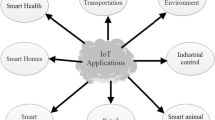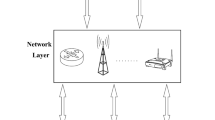Abstract
The rapid procreation of internet of things (IoT) has invigorated massive research efforts with the purpose to save and use the lifetime of battery-powered sensor nodes which ultimately increases the overall network lifetime. The erroneous and faulty states of these networks are due to the high consumption of batteries in the processing and transmission of data by these nodes. This research focuses on message scheduling in an IoT environment where things/sensors are connected to make IoT groups, where each group has a designated broker whose duty is to delivers the messages coming from the group members to the ultimate sink of the sensed data. At broker a message scheduler operating to decides which message goes first. This algorithm proposed cross layer architecture at application level and network level. The residual energy of the node and its distance is considered as a parameter while selecting broker among all nodes in new proposed methods as compared to traditional LEACH. The proposed method provides better results in terms of number of live nodes, network life time, number of brokers and total dissipated energy while stabilizing the response time of the messages in addition to it.








Similar content being viewed by others
References
Misra, G., Kumar, V., Agarwal, A., & Agarwal, K. (2016). Internet of things (iot)a technological analysis and survey on vision, concepts, challenges, innovation directions, technologies, and applications (an upcoming or future generation computer communication system technology). American Journal of Electrical and Electronic Engineering, 4(1), 23–32.
Mingjun, W., Zhen, Y., Wei, Z., Xishang, D., Xiaofei, Y., Chenggang, S., Xuhong, L., Fang, W., & Jinghai, H. (2012). A research on experimental system for internet of things major and application project. In System science, engineering design and manufacturing informatization (ICSEM), 2012 3rd international conference on, volume 1, pp. 261–263. IEEE.
Mokhtar, S. et al. (2012). Delivery of service oriented architecture with web services.
De, S., Barnaghi, P., Bauer, M., & Meissner, S. (2011). Service modelling for the internet of things. In Computer science and information systems (FedCSIS), 2011 Federated conference on, pp. 949–955. IEEE.
Abdullah, S., & Yang, K. (2013). An energy-efficient message scheduling algorithm in internet of things environment. In Wireless communications and mobile computing conference (IWCMC), 2013 9th international, pp. 311–316. IEEE.
Zaman, N., Tang Jung, L., & Yasin, M. M. (2016). Enhancing energy efficiency of wireless sensor network through the design of energy efficient routing protocol. Journal of Sensors.
Rezaei, Z., & Mobininejad, S. (2012). Energy saving in wireless sensor networks. International Journal of Computer Science and Engineering Survey, 3(1), 23.
Gupta, A., Gupta, M., & Nayyar, A. (2014). Improved energy efficiency and reduced delay using self-knowledge with SCHP in wireless sensor networks. International Journal of Advanced Research in Computer Science and Management Studies, 2(8).
Imon, S. K. A., Khan, A., Francesco, M. D., & Das, S. K. (2015). Energy-efficient randomized switching for maximizing lifetime in tree-based wireless sensor networks. IEEE/ACM Transactions on Networking (TON), 23(5), 1401–1415.
Amsalu, S. B., Zegeye, W. K., Hailemariam, D., Astatke, Y., & Moazzami, F. (2016). Energy efficient grid clustering hierarchy (GCH) routing protocol for wireless sensor networks. In Ubiquitous computing, electronics and mobile communication conference (UEMCON), IEEE Annual, pp. 1–6. IEEE.
Jie, D., Xiong, W., Sheng, W., & Shizhong, X. (2015). HHR: Hierarchical hybrid routing scheme for information-centric network. China Communications, 12(6), 141–153.
Perera, C., Jayaraman, P. P., Zaslavsky, A., Georgakopoulos, D., & Christen, P. (2014). Mosden: An internet of things middleware for resource constrained mobile devices. In System sciences (HICSS), 2014 47th Hawaii International Conference on, pp. 1053–1062. IEEE.
Ejaz, W., Naeem, M., Shahid, A., Anpalagan, A., & Jo, M. (2017). Efficient energy management for the internet of things in smart cities. IEEE Communications Magazine, 55(1), 84–91.
Krishna, K. H., Kumar, T., & Babu, Y. S. (2017). Energy effectiveness practices in WSN over simulation and analysis of S-MAC and leach using the network simulator NS2. In I-SMAC (IoT in social, mobile, analytics and cloud) (I-SMAC), 2017 international conference on, pp. 914–920. IEEE.
Aparicio, J., Echevarria, J. J., & Legarda, J. A. (2017). A software defined networking approach to improve the energy efficiency of mobile wireless sensor networks. IEEE Transactions on International Information Systems, 11, 2848–2869.
Sultanpure, K. A., Gupta, A., & Reddy, L. S. S. (2018). An efficient cloud scheduling algorithm for the conservation of energy through broadcasting. International Journal of Electrical and Computer Engineering (IJECE), 8(1), 179–188.
Mittal, N., Singh, U., & Sohi, B. S. (2017). A novel energy efficient stable clustering approach for wireless sensor networks. Wireless Personal Communications, 95(3), 2947–2971.
Marappan, P., & Rodrigues, P. (2016). An energy efficient routing protocol for correlated data using CL-LEACH in WSN. Wireless Networks, 22(4), 1415–1423.
Author information
Authors and Affiliations
Corresponding author
Additional information
Publisher's Note
Springer Nature remains neutral with regard to jurisdictional claims in published maps and institutional affiliations.
Rights and permissions
About this article
Cite this article
Abdullah, S., Asghar, M.N., Ashraf, M. et al. An Energy-Efficient Message Scheduling Algorithm with Joint Routing Mechanism at Network Layer in Internet of Things Environment. Wireless Pers Commun 111, 1821–1835 (2020). https://doi.org/10.1007/s11277-019-06959-x
Published:
Issue Date:
DOI: https://doi.org/10.1007/s11277-019-06959-x




